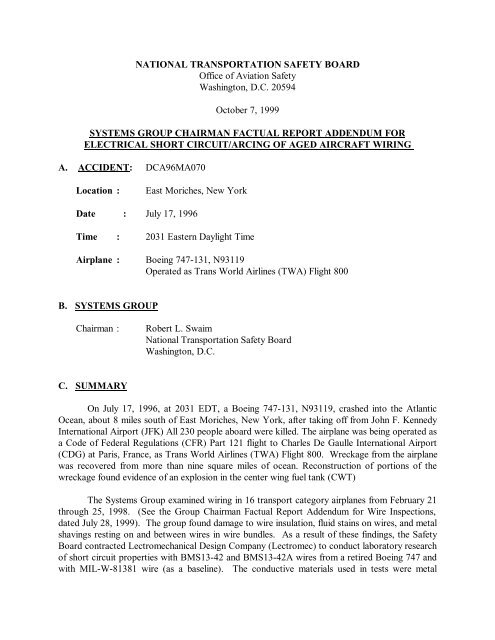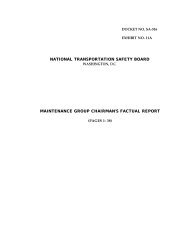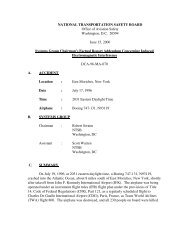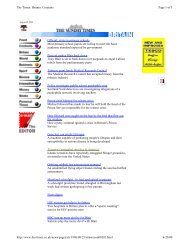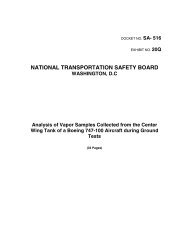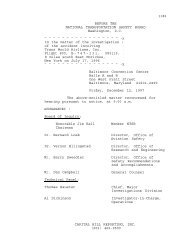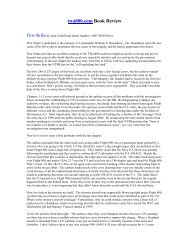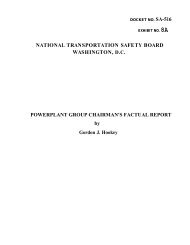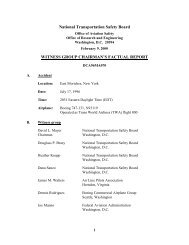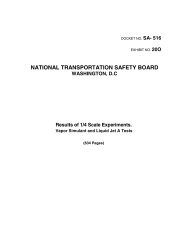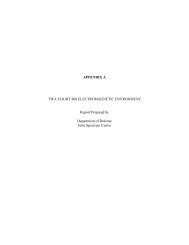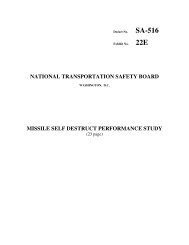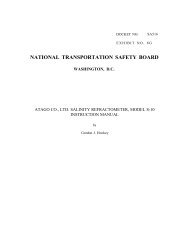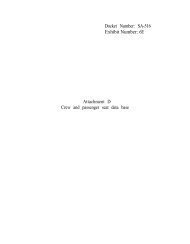Electrical Short Circuit/Arcing of Aged Aircraft Wiring
Electrical Short Circuit/Arcing of Aged Aircraft Wiring
Electrical Short Circuit/Arcing of Aged Aircraft Wiring
You also want an ePaper? Increase the reach of your titles
YUMPU automatically turns print PDFs into web optimized ePapers that Google loves.
<strong>Electrical</strong> <strong>Arcing</strong> <strong>of</strong> <strong>Aged</strong> <strong>Aircraft</strong> Wirefor theNational Transportation Safety Board490 L’Enfant Plaza East, S.W.Washington, DC 20594Robert Swaim,Chairman, TWA800 Systems Groupperformed underOrder No. NTSB18-99-SP0127Report No. N191-RPT4AU99byLectromechanical Design Company45000 Underwood Lane, Suite LSterling, Virginia 20166-2305Tel: (703) 481 – 1233Tel: (703) 481 – 1238Report Date: August 4, 1999Copy 01
EXECUTIVE SUMMARYThis report describes the results <strong>of</strong> several different tests relating to the short circuitproperties <strong>of</strong> aged wires. The two types <strong>of</strong> wire insulations were crosslinked aliphaticpolyimide-insulated (BMS13-42 and BMS13-42A) wire and a tape-wrapped aromatic polyimide(MIL-W-81381). The BMS wire had been removed from a Boeing 747 airplane (N93117) thathad been in service for more than 25 years. The MIL-W-81381 was used for comparison and abaseline to existing data.The following four types <strong>of</strong> tests were conducted:Wet short-circuit between conductors with a 1% saline-water electrolyte solution,conducted to SAE test standard AS4373 4.5.9 Method 509 (with deviations) forup to 25 minutes.Wet short-circuit between conductors with lavatory fluid taken from an airplane.Abrasion tests that placed metal shavings between oscillating wires.<strong>Short</strong> circuit tests using metal shavings as the conductor.There were three different categories <strong>of</strong> electrical activity observed during the arcingexperiments. Each <strong>of</strong> these activities had unique visual and oscillograph signatures.Scintillations: high frequency, micro-discharges which causes formation <strong>of</strong> char on thewire over time.Flashing: an arcing discharge which can continue over several cycles but not 100s <strong>of</strong>cycles. Typically 2 to 4 joules <strong>of</strong> electrical energy are transfer between source andtarget wire but in some cases up to 90 joules were transferred. Flashing will notcause circuit breakers to open (trip) but will erode the conductors over time.Strong arcing: an arcing discharge that continues over 100s <strong>of</strong> cycle and <strong>of</strong>ten endswithinterruption <strong>of</strong> power due to the circuit breaker tripping. Typically 5kilojoules <strong>of</strong> electrical energy were dissipated in strong arcing eventsStrong arcing was not associated with W42A/8/1-20 wire, but was found in 1 <strong>of</strong> 3 teststhat used W42/1/1-20 wire, which has a thinner layer <strong>of</strong> insulation. Strong arcing alwaysresulted during wet testing <strong>of</strong> MIL-W-81381.Half-sections <strong>of</strong> aluminum tube were placed behind the wet tests to provide a backdropfor video-recording and to capture material ejected by the short circuit event. Flashing andarcing were normally directional, not a ball-shaped discharge. The direction <strong>of</strong> the dischargewas normally away from the side <strong>of</strong> the wire bundle that the wires were on and the discharge <strong>of</strong>some tests did not hit the aluminum tube sections.More than one type <strong>of</strong> abrasion test was performed to examine how metal shavingsdamaged BMS13-42 and BMS13-42A (no MIL-W-81381) wire insulation. The metal shavings<strong>Electrical</strong> <strong>Arcing</strong> <strong>of</strong> <strong>Aged</strong> <strong>Aircraft</strong> Wire.Lectromechanical Design CompanyReport No. N191-RPT4AU99 August 12, 1999i
were placed between wires in small bundles, as found during Safety Board tests <strong>of</strong> February 21-25, 1998, and the bundles were moved with an oscillating bar. The results depended ondifferences in how the bundles were moved and the size <strong>of</strong> the shavings. In one configurationtwo <strong>of</strong> four (50%) tests resulted in the metal shaving exposing the conductor. In a secondconfiguration, neither <strong>of</strong> two (0%) tests resulted in the shavings exposing the conductor.However during these tests three separate wires had cracks appear in the insulation due to the ½inch oscillatory flexing after about 19 hoursTests were conducted to document the short-circuit capability <strong>of</strong> the metal shavings onwires that already had the conductor exposed. In five <strong>of</strong> eight (62.5%) <strong>of</strong> the tests, the metalshaving acted as a fusible link, interrupting the short-circuit without causing additional damageto the insulation. In the other three tests (37.5%) damage was done to the adjacent wires duringthe flash event, but in no case did strong arcing occur.<strong>Electrical</strong> <strong>Arcing</strong> <strong>of</strong> <strong>Aged</strong> <strong>Aircraft</strong> Wire.Lectromechanical Design CompanyReport No. N191-RPT4AU99 August 12, 1999ii
Table <strong>of</strong> ContentsBackground...................................................................................................... 1Experimental Procedures................................................................................. 3Description <strong>of</strong> electrical activity...................................................................... 9Results: Summary Tables.....................................................................................15Appendix A: Descriptions <strong>of</strong> individual tests...................................................19Appendix B: Different Experiment Configurations ...........................................52<strong>Electrical</strong> <strong>Arcing</strong> <strong>of</strong> <strong>Aged</strong> <strong>Aircraft</strong> Wire.Lectromechanical Design CompanyReport No. N191-RPT4AU99 August 12, 1999iii
BackgroundArc tracking <strong>of</strong> aircraft wire is an issue that has received attention in the past 1, 2 because<strong>of</strong> the potential for equipment malfunction and because it can be a safety risk. There now arecommon standards for testing different aspects <strong>of</strong> arcing in qualification tests for new wire.One <strong>of</strong> these aspects is the wet arc tracking <strong>of</strong> the wire. On aircraft, liquids do get ontowires for a variety <strong>of</strong> reasons: spilled beverages, leaking lavatory water, condensation, ormoisture absorbed into salt or other surface contaminates. This can lead to carbon tracking whichis a process where a conducting carbon path is slowly built up over time due to low levelelectrical discharges on the surface <strong>of</strong> the wire. Figure 1 shows an example <strong>of</strong> carbon build up on81381 type wires. This carbon build up can lead to arcing.Another potential issue is metal drill shaving on and in wire bundles and the potential formechanical damage to the insulation. The Safety Board investigation documented numerouscases <strong>of</strong> metal shavings on wire bundles and between the wires <strong>of</strong> bundles. Figure 2 shows anexample <strong>of</strong> this.1. F. C. Campbell, Flashover Failures from Wet-Wire <strong>Arcing</strong> and Tracking, NRL Memorandum Report 5508, pg. 1,Naval Research Laboratory, Washington, DC, (1984)2. P. L Cahill and J. H. Dailey, <strong>Aircraft</strong> <strong>Electrical</strong> Wet-Wire Arc Tracking, Report No. DOT/FAA/CT-88/4, FAATechnical Center, Atlantic City, NJ, (1988)<strong>Electrical</strong> <strong>Arcing</strong> <strong>of</strong> <strong>Aged</strong> <strong>Aircraft</strong> Wire.Lectromechanical Design CompanyReport No. N191-RPT4AU99 August 12, 19991
Figure 1. A bundle <strong>of</strong> Mil-W-81381 wire with visible carbon tracking .Figure 2. Metal drill shaving on a wire bundle <strong>of</strong> a commercial aircraft.<strong>Electrical</strong> <strong>Arcing</strong> <strong>of</strong> <strong>Aged</strong> <strong>Aircraft</strong> Wire.Lectromechanical Design CompanyReport No. N191-RPT4AU99 August 12, 19992
EXPERIMENTAL PROCEDURESWet Arc Tracking:The Wet Arc Tracking Test followed the SAE standard AS4373 4.5.9 method 509 testprocedures with certain deviations. In this test, a bundle <strong>of</strong> 7 wires (six around one) is suspendedhorizontally in a test chamber (Figure 3). The insulation on the top two wires (A1, B1) in thisbundle have been pre-damaged with circumferential cuts such that the conductor is clearlyvisible. The cuts are aligned so that they are separated by 6 mm.The bundle is connected to a 10 kVA, 3 phase, 400 Hz, 120 Vac line to neutral generatorusing the circuit shown in Figure 4. In this circuit, a 7.5 Amp circuit breaker and a 1 ohm resistor(simulating a long run <strong>of</strong> wire) are placed in series with each <strong>of</strong> the top 5 wires (A1, B1, C, A2,B2) which are called the active wires. The bottom two wires (D1, D2) are not connected to thegenerator (they are floating) and are called the passive wires.An Electrolytic solution is dripped on the wire such that the drop lands between the cutsin the insulation. In these tests two different electrolytes were used; A 1% by weight NaClsolution or lavatory waste water. The electrolyte was dripped at a rate <strong>of</strong> six drops per minute(100 mg/min) except in Test 1 when the rate was 10 drops/min.The experiment was allowed to run for 10 to 25 minutes or until a circuit breaker tripped.The circuit breakers were sometimes reset once or twice. After the test, the bundle was removedand a wet dielectric test was run on the 5 wires that were not pre-damaged (C, A2, B2, D1, D2).Shaving <strong>Short</strong> <strong>Circuit</strong>In this test a 7 wire bundle is used with two <strong>of</strong> the wires having circumferential cuts (~ 1mm wide) placed in the insulation so that the conductor is visible. These pre-damaged wires areplaced on opposite sides <strong>of</strong> the bundle and a metal shaving is woven through the bundle so thatin touches both <strong>of</strong> the exposed conductors. The bundle is suspended horizontally and the wiresare connected to the generator (see Figure 5). The experiment is started when the contactor isclosed and ends when a circuit breaker is tripped or the circuit opens due to evaporation <strong>of</strong> theshaving.Metal Shavings Abrasion TestMany different experimental setups were tried for the metal shavings abrasion tests withvarying results. Some created damage to the wire insulation and flashing events and others didnot. Two setups used are described here while others are described in Appendix B.90° (Right Angle) TestIn this test, one bundle <strong>of</strong> seven wires was used with a metal shaving, at least 0.5" long, woveninto the bundle. One end <strong>of</strong> the wire was secured to a stationary platform with a P-clamp whilethe other end was secured several inches away at 90 degrees from the direction <strong>of</strong> the first P-clamp, on an oscillating bar. The bundle had the form <strong>of</strong> a circular arc <strong>of</strong> about a 2" radius<strong>Electrical</strong> <strong>Arcing</strong> <strong>of</strong> <strong>Aged</strong> <strong>Aircraft</strong> Wire.Lectromechanical Design CompanyReport No. N191-RPT4AU99 August 12, 19993
Figure 3. A wire bundle suspended in the wet arc track testing apparatus.(Insert is <strong>of</strong> thepre-damage cuts in the top wires.)Figure 4. <strong>Circuit</strong> used in the wet arc tracking tests.<strong>Electrical</strong> <strong>Arcing</strong> <strong>of</strong> <strong>Aged</strong> <strong>Aircraft</strong> Wire.Lectromechanical Design CompanyReport No. N191-RPT4AU99 August 12, 19994
Figure 5. <strong>Circuit</strong> used in the metal shavings short circuit tests.Figure 6. Apparatus used for metal shaving abrader test 90° (right angle).<strong>Electrical</strong> <strong>Arcing</strong> <strong>of</strong> <strong>Aged</strong> <strong>Aircraft</strong> Wire.Lectromechanical Design CompanyReport No. N191-RPT4AU99 August 12, 19995
as shown in Figure 6.The linear motion <strong>of</strong> the rod causes the wires in the bundle to squeezetogether on the shaving and then relax repeatedly..The wires are connected to the generator and the linear motion is started. The testcontinues until an electrical event occurs or all <strong>of</strong> the metal shavings have worked their way out<strong>of</strong> the bundleLongitudinal TestIn this test set-up two identical wire bundles are made from three 20 gauge wires and one18 gauge wire as shown in Figure 7. Each bundle was held together with lacing tape. One <strong>of</strong> thebundles is secured to a stationary platform with P-clamps and tape. The other bundle is secure toan oscillating bar. The two bundles are parallel at this point and are kept together with nylon tieswith several metal shavings placed between the two bundles (Figure 8).The three 20 gauge wires in both bundles are each connected to one <strong>of</strong> three phases <strong>of</strong> thegenerator as shown in Figure 8. The 18 gauge wire is also connected to one <strong>of</strong> the phases.The oscillator is then turned on. The test continues until an electrical event occurs or all<strong>of</strong> the metal shavings have work their way out <strong>of</strong> the bundle.Figure 7. <strong>Circuit</strong> used for metal shaving abrasion tests (longitudinal).<strong>Electrical</strong> <strong>Arcing</strong> <strong>of</strong> <strong>Aged</strong> <strong>Aircraft</strong> Wire.Lectromechanical Design CompanyReport No. N191-RPT4AU99 August 12, 19996
Figure 8. Apparatus used for metal shaving abrasion tests (longitudinal).Wet Dielectric Test:This test was run according to AS 4373 4.5.10 with some deviations. In the test theindividual wires were placed in a water bath with both ends out <strong>of</strong> the water (Figure 9). 1000VDC was applied to the wire conductor and the water bath was grounded. If a current wasmeasured in the circuit it meant that the wire shorted through the insulation to the water bath.<strong>Electrical</strong> <strong>Arcing</strong> <strong>of</strong> <strong>Aged</strong> <strong>Aircraft</strong> Wire.Lectromechanical Design CompanyReport No. N191-RPT4AU99 August 12, 19997
Figure 9. <strong>Circuit</strong> used for the wet dielectric tests.<strong>Electrical</strong> <strong>Arcing</strong> <strong>of</strong> <strong>Aged</strong> <strong>Aircraft</strong> Wire.Lectromechanical Design CompanyReport No. N191-RPT4AU99 August 12, 19998
DESCRIPTION OF ELECTRICAL ACTIVITYThree different categories <strong>of</strong> electrical activity were recorded during the arcingexperiments. They were scintillations, flashing and strong arcing. Each <strong>of</strong> these activitiesdeveloped a unique visual and oscillograph signature.ScintillationScintillations were the first electrical activity that was observed during the experiments.Visually, they began as pinpoints <strong>of</strong> light that flickered at the edge <strong>of</strong> the pre-damaged cracks inthe insulation (Figure 10). As time went on and a char track built up on the insulation, theflickers <strong>of</strong> light appeared at various places along the path between the pre-damaged cracks.During the more lively scintillations an electrical buzzing or crackling sounds could be heard. Noscintillations caused a circuit breaker to disrupt power.Figure 10. Scintillation at the edge <strong>of</strong> a pre-damaged crack.An oscillogram <strong>of</strong> scintillations (Figure 11) showed them to be high frequency eventswhich distorted the current and voltage waveforms. The frequency components appear to begreater than 1 megahertz. Quantitative measurements at these frequencies require the inductancesand capacitances <strong>of</strong> each <strong>of</strong> the components <strong>of</strong> the circuit (i.e. generator, circuit resistors,oscilloscope etc.) to be measured and analyzed which was not in the scope <strong>of</strong> this work. Energytransfer between wires cause voltage distortions (noise) and this process caused changes to theinsulation as a char path was built.<strong>Electrical</strong> <strong>Arcing</strong> <strong>of</strong> <strong>Aged</strong> <strong>Aircraft</strong> Wire.Lectromechanical Design CompanyReport No. N191-RPT4AU99 August 12, 19999
Figure 11. Oscillogram <strong>of</strong> voltage from phase A to B (blue) and current in phase A (red)during scintillations.FlashingThe flashing events usually occurred after the sample has been scintillating for sometime. As the name suggests what is seen is a single flash <strong>of</strong> light with an accompanying poppingsound. When flashing begins to occur on a sample there are usually many seconds or evenminutes between events. However, as time continues the frequency <strong>of</strong> these events increases tothe point where there may be several events per second. Most samples would go through aperiod <strong>of</strong> tens <strong>of</strong> seconds <strong>of</strong> rapid flashing followed by several minutes <strong>of</strong> dormancy. Figure 12shows an example <strong>of</strong> a flashing event captured by video recording. The flash <strong>of</strong>ten showed up inonly one frame with the framing rate being 50 frames per second (1 every 20 milliseconds).None <strong>of</strong> the flashing events caused a circuit breaker to open. The longest wet test conducted was25 minutes.The oscillogram (Figure 13) shows that the waveform during a flashing event is that <strong>of</strong> aclassical arcing event 3 . The blue line represents the voltage between the two pre-damaged wiresand begins with a normal 400 Hz sine waveform. However in the next cycle the voltagecollapses into a classic arc waveform with a relatively constant arc voltage <strong>of</strong> ~ 100 volts. Thevoltage then returns to the normal sine waveform. Looking at the red line representing thecurrent in the wire, there is little to no current to the left. During the arcing event the current risesto a peak <strong>of</strong> 65 amperes and then returns to zero current as the voltage waveform returns tonormal.3. Cobine J. D. Gaseous Conductors, Dover Publication, New York, 1958, pgs. 348 and 353.<strong>Electrical</strong> <strong>Arcing</strong> <strong>of</strong> <strong>Aged</strong> <strong>Aircraft</strong> Wire.Lectromechanical Design CompanyReport No. N191-RPT4AU99 August 12, 199910
The voltage and current waveforms were used to calculate the electrical energy dissipatedin the arc. Figure 14 shows the electrical power during a flashing event, it reaching a peak <strong>of</strong> 8kilowatts (kW). The total electrical energy dissipated was about 4 joules 4 . Over time the flashingcan cause damage to the insulation and the conductor.Figure12. An example <strong>of</strong> a flashing event.4. This is the energy needed to melt about 6 milligrams <strong>of</strong> aluminum, the equivalent <strong>of</strong> a fraction <strong>of</strong> a paper clip<strong>Electrical</strong> <strong>Arcing</strong> <strong>of</strong> <strong>Aged</strong> <strong>Aircraft</strong> Wire.Lectromechanical Design CompanyReport No. N191-RPT4AU99 August 12, 199911
Figure 13. Oscillogram <strong>of</strong> voltage and current during a flashing event.Figure 14. The electrical power dissipated during a flash event.<strong>Electrical</strong> <strong>Arcing</strong> <strong>of</strong> <strong>Aged</strong> <strong>Aircraft</strong> Wire.Lectromechanical Design CompanyReport No. N191-RPT4AU99 August 12, 199912
Figure 15. Example <strong>of</strong> a strong arcing event.Strong <strong>Arcing</strong>Strong <strong>Arcing</strong> events were characterized by an active bright flash or glow that continuedfor a up to a second or more (Figure 15) with an intense electrical hum or crackling. The arc cancause much collateral damage to the insulation <strong>of</strong> adjacent wires, some <strong>of</strong> which becameinvolved in the event. Strong arcing was <strong>of</strong>ten terminated with tripping <strong>of</strong> the circuit breaker.The difference between the oscillogram <strong>of</strong> a flash and a strong arcing event is that thesame voltage arc waveform is repeated continuously in the arc at each half cycle for the duration<strong>of</strong> the short circuit. The phase to phase voltage at the beginning <strong>of</strong> an arc is shown in Figure 16 .The current in this arc started out in the range <strong>of</strong> 65 amperes (peak). After the other wires(including the phase C wire) became involved in the arc the current increased to peaks <strong>of</strong> 120amperes. Power peaks were found <strong>of</strong> up to 15 kW (Figure 17) and a total electrical energydissipated <strong>of</strong> about 5 kilojoules (kJ) .The magnitudes <strong>of</strong> the power peaks in the strong arcing event shown in Figure 17 areabout a factor <strong>of</strong> 2 higher than those found in the flashing event previously discussed becausemore wires were involved. Also different is the arc waveform is repeating continuously forhundreds <strong>of</strong> cycles in a strong arcing event, as compared to one to ten or twenty cycles for aflashing event. This increases the time in which energy is dissipated in a strong arcing event.<strong>Electrical</strong> <strong>Arcing</strong> <strong>of</strong> <strong>Aged</strong> <strong>Aircraft</strong> Wire.Lectromechanical Design CompanyReport No. N191-RPT4AU99 August 12, 199913
Figure 16. Oscillogram <strong>of</strong> voltage at the beginning <strong>of</strong> a strong arcing event.Figure 17. Power in strong arcing event, extrapolated from two phase measurement.<strong>Electrical</strong> <strong>Arcing</strong> <strong>of</strong> <strong>Aged</strong> <strong>Aircraft</strong> Wire.Lectromechanical Design CompanyReport No. N191-RPT4AU99 August 12, 199914
RESULTSTable 1 lists the Test run giving the type <strong>of</strong> test and type <strong>of</strong> wire sample used. Tables 2 to5 are summaries <strong>of</strong> the results <strong>of</strong> each <strong>of</strong> the test. Appendix A has a detailed description for each<strong>of</strong> the individual tests.Table 1. List <strong>of</strong> Tests and types <strong>of</strong> wire used.Test Number Test Type Sample Wire TypePreliminary Test 1 Wet Arc Tracking BMS-W42/1/1-20Preliminary Test 2 Wet Arc Tracking BMS-W42/1/1-20Test 1 Wet Arc Tracking BMS-W42A/8/1-20Test 2 Wet Arc Tracking BMS-W42A/8/1-20Test 3 Wet Arc Tracking BMS-W42/1/1-20Test 4 Wet Arc Tracking Mil-W-81381/12-20Test 5 Wet Arc Tracking Mil-W-81381/12-20Test 6 Wet Arc Tracking BMS-W42A/8/1-20Test 7 Wet Arc Tracking BMS-W42A/8/1-20Test 8 Metal Shavings <strong>Short</strong> <strong>Circuit</strong> BMS-W42A/8/1-16Test 9 Metal Shavings <strong>Short</strong> <strong>Circuit</strong> BMS-W42A/8/1-16Test 10 Metal Shavings <strong>Short</strong> <strong>Circuit</strong> BMS-W42A/8/1-16Test 11 Metal Shavings <strong>Short</strong> <strong>Circuit</strong> BMS-W42A/8/1-16Test 12 Metal Shavings <strong>Short</strong> <strong>Circuit</strong> BMS-W42/1/1-20Test 13 Metal Shavings <strong>Short</strong> <strong>Circuit</strong> BMS-W42/1/1-20Test 14 Metal Shavings <strong>Short</strong> <strong>Circuit</strong> BMS-W42A/8/1-20Test 15 Metal Shavings <strong>Short</strong> <strong>Circuit</strong> BMS-W42A/8/1-20Test 16 Metal Shavings Abrasion (90 °) BMS-W42A/8/1-20Test 17 Metal Shavings Abrasion (long.) BMS-W42/1/1-20Test 18 Metal Shavings Abrasion (long.) BMS-W42/1/1-20Test 19 Metal Shavings Abrasion (long.) BMS-W42/1/1-20Test 20 Metal Shavings Abrasion (long.) BMS-W42/1/1-20<strong>Electrical</strong> <strong>Arcing</strong> <strong>of</strong> <strong>Aged</strong> <strong>Aircraft</strong> Wire.Lectromechanical Design CompanyReport No. N191-RPT4AU99 August 12, 199915
Table 2. Summary <strong>of</strong> Wet Arc Tracking Results: Grouped according to wire typeWire Spec Test # Electrolyte Duration Qualitative Description# <strong>Circuit</strong> BreakersTripped# <strong>of</strong> Wires thatFailed WetDielectric TestLength <strong>of</strong> Damage/Char Build upW 42A/8/1-20 Test 1 1% NaCl 20 min. Some intense flashing 0 2 <strong>of</strong> 5 1/2"W 42A/8/1-20 Test 2 1% NaCl 25 min. Some intense flashing 0 2 <strong>of</strong> 5 5/8"W 42A/8/1-20 Test 6 Lav. Water 10 min. Some intense flashing 0 2 <strong>of</strong> 5 1/4"W 42A/8/1-20 Test 7 Lav. Water 16 min. Some intense flashing 0 0 <strong>of</strong> 5 3/8"W 42/1/1-20 Pre Test A 1% NaCl 5 min Some intense flashing 0 NA 1/2"W 42/1/1-20 Pre Test B 1% NaCl
Table 3. Summary <strong>of</strong> Metal Shavings <strong>Short</strong> <strong>Circuit</strong> Test: Grouped according to wire typeWire Spec Test # ShavingMaterialShavingCross section(Mils)<strong>Circuit</strong>Breaker/<strong>Circuit</strong>ResistorQualitativeDescription# <strong>Circuit</strong>BreakersTripped# <strong>of</strong> Wires thatFailed WetDielectric TestLength <strong>of</strong> Damage/Char Build upW 42A/8/1-16 Test 8 Steel 110 X 9 7.5 Amp/ 1 Ω <strong>Short</strong> Flash 0 0 <strong>of</strong> 5 0"W 42A/8/1-16 Test 9 Steel 65 X 28 15 Amp/ 0.5 Ω Intense Flash 0 5 <strong>of</strong> 5 1.5"W 42A/8/1-16 Test 10 Steel 48 X 26 15 Amp/ 0.5 Ω <strong>Short</strong> Flash 0 2 <strong>of</strong> 5 1/8"W 42A/8/1-16 Test 11 Al 7075 120 X 6 15 Amp/ 0.5 Ω <strong>Short</strong> Flash 0 0 <strong>of</strong> 5 0"W 42/1/1-20 Test 12 Steel 51 X 10 7.5 Amp/ 1 Ω <strong>Short</strong> Flash 0 1 <strong>of</strong> 5 1/4"W 42/1/1-20 Test 13 Al 7075 50 X 8 7.5 Amp/ 1 Ω <strong>Short</strong> Flash 0 0 <strong>of</strong> 5 0"W 42A/8/1-20 Test 14 Steel 52 X 9 7.5 Amp/ 1 Ω <strong>Short</strong> Flash 0 0 <strong>of</strong> 5 0"W 42A/8/1-20 Test 15 Al 7075 70 X 8 7.5 Amp/ 1 Ω <strong>Short</strong> Flash 0 0 <strong>of</strong> 5 0"<strong>Electrical</strong> <strong>Arcing</strong> <strong>of</strong> <strong>Aged</strong> <strong>Aircraft</strong> Wire.Lectromechanical Design CompanyReport No. N191-RPT4AU99 August 12, 199917
Table 4. Summary <strong>of</strong> Metal Shavings Abrasion Test: 90° (Right Angle)Wire Spec Test # ShavingMaterialShaving Crosssection (Mils) Duration QualitativeDescription# <strong>Circuit</strong>BreakersTripped# <strong>of</strong> Wires thatFailed WetDielectric TestInsulation DamageW 42A/8/1-20 Test 16A Steel 41 X 26 19.25 hours No Flash 0 1 <strong>of</strong> 7 Moderate damage to PolyXFlexing broke 1 wireW 42A/8/1-20 Test 16B Al 7075 42 X 30 19.25 hours No Flash 0 2 <strong>of</strong> 7 Moderate damage to TopcoatFlexing broke/cracked 2 wiresTable 5. Summary <strong>of</strong> Metal Shavings Abrasion Test: LongitudinalWire Spec Test # ShavingMaterialShaving Crosssection (Mils) Duration QualitativeDescription# <strong>Circuit</strong>BreakersTripped# <strong>of</strong> Wires thatFailed WetDielectric TestInsulation DamageW 42/1/1-20 Test 17 Steel ~40 X 25 1+ hours Small Flash 0 2 <strong>of</strong> 8 Cuts in Poly X to the conductorW 42/1/1-20 Test 19 Steel 49 X 18 4 hours No Flash 0 2 <strong>of</strong> 8 Cuts in Poly X to the conductorW 42/1/1-20 Test 18 Al 7075 48 X 26 ~15 minute No Flash 0 0 <strong>of</strong> 8 Abrasion <strong>of</strong> TopcoatW 42/1/1-20 Test 20 Al 7075 120 X 6 4 hours No Flash 0 0 <strong>of</strong> 8 Abrasion <strong>of</strong> Topcoat<strong>Electrical</strong> <strong>Arcing</strong> <strong>of</strong> <strong>Aged</strong> <strong>Aircraft</strong> Wire.Lectromechanical Design CompanyReport No. N191-RPT4AU99 August 12, 199918
APPENDIX A: Description <strong>of</strong> Individual Test ResultsWet Arc Tracking TestsPreliminary Tests A & BWet Arc TrackingBundle: Seven wires (6 over 1) <strong>of</strong> BMS 42/1/1-20 specification, 15 inches in length.Electrolyte: 1% saline solution @ 100mg/minute<strong>Circuit</strong> Resistance: 1 OhmGenerator: 3 phase, 400Hz, 120 line to neutral (208 line to line), 10 kVA.Length <strong>of</strong> tests: 5 minutes (Test A) and ½ minute (Test B)ObservationPreliminaryTest APreliminaryTest BVisible scintillation Yes YesFlash Yes YesStrong <strong>Arcing</strong> No Approaching<strong>Circuit</strong> Breakers Tripped No NoDamage Length 1/2" 1/4"Number <strong>of</strong> Wires Failing WetDielectric TestBoth tests gave similar results although preliminary test A was run for 5 minutes andpreliminary test B was run for only ½ <strong>of</strong> a minute. Both began scintillations almost immediatelyand soon developed flashing type events.In test A the sample was very active for the first minute or so and then had periods <strong>of</strong>dormancy interrupted by short spurts <strong>of</strong> activity. Examination <strong>of</strong> the bundle shows damage andchar for about ½ an inch around the pre-damaged cuts. Also, about 3/8 <strong>of</strong> the conductors <strong>of</strong> thetop two wires had been eroded away (Figure 18).The bundle in test B experienced a period <strong>of</strong> intense activity within the first 30 secondsapproaching strong arcing with 20+ cycles <strong>of</strong> continuous arcing (Figure 19). This periodincluded current peaks <strong>of</strong> 75 Amperes and over 350 joules <strong>of</strong> electrical energy was dissipated inthe event. The sample was then removed and examined. There was about a 1/4 inch <strong>of</strong> damageand char build up around the cut in the insulation, but both conductors were still intact.No circuit breaker tripped in either test.__<strong>Electrical</strong> <strong>Arcing</strong> <strong>of</strong> <strong>Aged</strong> <strong>Aircraft</strong> Wire.Lectromechanical Design CompanyReport No. N191-RPT4AU99 August 12, 199919
Figure 18. Preliminary Test A: Bundle after wet arc track testing for 5 minutes.Figure 19.Preliminary Test B: Oscillogram <strong>of</strong> current during intense flashing event.<strong>Electrical</strong> <strong>Arcing</strong> <strong>of</strong> <strong>Aged</strong> <strong>Aircraft</strong> Wire.Lectromechanical Design CompanyReport No. N191-RPT4AU99 August 12, 199920
Test 1 & 2Wet Arc TrackingBundle: Seven wires (6 over 1) <strong>of</strong> BMS 42A/8/1-20 specification, 15 inches in length.Electrolyte: 1% saline solution @ 200 mg/minute (test 1) , 100 mg/minute (test 2)<strong>Circuit</strong> Resistance: 1 OhmGenerator: 3 phase, 400Hz, 120 line to neutral (208 line to line), 10 kVA.Length <strong>of</strong> test: 20 minutes (Test 1), 25 minutes (Test 2)Observation Test 1 Test 2Visible scintillation 00:23 00:15Flash 16:01 8:44Strong <strong>Arcing</strong> No No<strong>Circuit</strong> Breakers Tripped No NoDamage Length 1/2" 5/8"Number <strong>of</strong> Wires Failing WetDielectric Test2 <strong>of</strong> 5[C] & [B2]2 <strong>of</strong> 5[C] & [A2]The results <strong>of</strong> Test 1 and Test 2 were similar to each other though Test 2 did becomemore active a little sooner than did Test 1. Visible scintillations began within the first minute <strong>of</strong>the tests. In a couple <strong>of</strong> minutes, a char path began to develop between the two pre-damagedcracks in the insulation and scintillations were observed along this path. This is shown in Figure20.As the tests went on flashing events began to take place. At first the flashing events wereat least several seconds apart, sometimes they were up to a minute apart. Soon there were periodswhere the flash events repeated continuously, sometime several flashes per second. This wasfollowed by periods <strong>of</strong> dormancy where no electrical activity was observed. The intensity <strong>of</strong> theflash events varied both in the light and sound produced sometimes lasting several frames <strong>of</strong>video. After a series <strong>of</strong> flashes a chemical combustion flame (candle-like flame) was observedburning the insulation for a few seconds (Figure 21). The samples were each tested between 20and 25 minutes and no circuit breakers tripped.Looking at the oscillograms taken during the more active times <strong>of</strong> the test, we see thatseveral <strong>of</strong> the flashing events lasted for 5 to 10 cycles. An example <strong>of</strong> this is shown in Figure 22which shows the current in one <strong>of</strong> the three phases during Test 1. The sequence begins with 8cycle consecutive cycles having high current for at least one <strong>of</strong> the ½ cycles and some times both<strong>of</strong> the ½ cycles. This is followed by a period intermittent cycles <strong>of</strong> high current lasting for 50milliseconds followed by another 5 cycles that had continuous arcing currents. Not shown inFigure 22, but recorded on the oscilloscope, is that there were no high current cycles for the next4 seconds (corresponding to more than a 1000 cycles).<strong>Electrical</strong> <strong>Arcing</strong> <strong>of</strong> <strong>Aged</strong> <strong>Aircraft</strong> Wire.Lectromechanical Design CompanyReport No. N191-RPT4AU99 August 12, 199921
Figure 20. Test 2: Scintillations along the built up char path.Figure 21. Test 2: A Chemical combustion flame observed after a series <strong>of</strong> flashing events.<strong>Electrical</strong> <strong>Arcing</strong> <strong>of</strong> <strong>Aged</strong> <strong>Aircraft</strong> Wire.Lectromechanical Design CompanyReport No. N191-RPT4AU99 August 12, 199922
Figure 22. Test 1: Oscillogram showing intermittent current during a flashing event.Examination <strong>of</strong> the bundles after the tests shows that the damage and char build up wasover a 1/2 to 5/8 inch length <strong>of</strong> the wire bundle. In each test, the conductor <strong>of</strong> 2 (test 1) or3 (test 2) <strong>of</strong> the wires were eroded away up to ½ <strong>of</strong> an inch. In test 1 the eroded conductors werefrom wire [A1] and wire [B2] (wire [B2] was not originally damaged but must have becomedamaged soon after the start <strong>of</strong> the test.). In each test, two <strong>of</strong> the five previously undamagedwires failed a wet dielectric test. Figure 23 shows the sample from Test 2 after being removedfrom the arc tracking apparatus.<strong>Electrical</strong> <strong>Arcing</strong> <strong>of</strong> <strong>Aged</strong> <strong>Aircraft</strong> Wire.Lectromechanical Design CompanyReport No. N191-RPT4AU99 August 12, 199923
Figure 23. Test 2: Sample bundle after 25 minutes <strong>of</strong> wet arc track testing.<strong>Electrical</strong> <strong>Arcing</strong> <strong>of</strong> <strong>Aged</strong> <strong>Aircraft</strong> Wire.Lectromechanical Design CompanyReport No. N191-RPT4AU99 August 12, 199924
Test 3Wet Arc TrackingBundle: Seven wires (6 over 1) <strong>of</strong> BMS 42/1/1-20 specification, 15 inches in length.Electrolyte: 1% saline solution @100mg/minute<strong>Circuit</strong> Resistance: 1 OhmGenerator: 3 phase, 400Hz, 120 line to neutral (208 line to line), 10 kVA.Length <strong>of</strong> test: 5 MinutesObservation Test 3Visible scintillation 00:10Flash 3:03Strong <strong>Arcing</strong> 3:11<strong>Circuit</strong> Breakers TrippedYesDamage Length 2"# Wires Failing WetDielectric Test5 <strong>of</strong> 5[C] ,[A2], [B2], [D1] & [D2]Scintillations were observed on the sample almost immediately after Test 3 was started.Several minutes in to the test, before a visible char track was developed a flash was observed. Onthe next drop <strong>of</strong> saline the sample burst into intense arcing that lasted less that a second anddamaged all <strong>of</strong> the active wires in the bundle though no circuit breakers were tripped (Figure 24).The sample became dormant for about 30 seconds before another burst <strong>of</strong> arcing which did tripthe circuit breaker in series with wire [C]. The arcing stopped and the sample was inactive forabout 5 minutes. At this point the circuit breaker was reset and the bundle arced again. This time3 circuit breakers [B1], [B2] and [C] were tripped and the arc stopped. The sample was thenremoved from the test apparatus.A look at the oscilloscope recording <strong>of</strong> the first burst <strong>of</strong> strong arcing shows that theevent lasted for less than 1/4 <strong>of</strong> a second and that all three phases became involved within 30milliseconds (Figure 25). There were many current peaks greater than 100 amperes during thearc. Estimates <strong>of</strong> the electrical energy dissipated in the two events before the circuit breakertripped is about 2 kilojoules. The second burst <strong>of</strong> arcing that resulted in the tripping <strong>of</strong> thecircuit breaker was not recorded because the data from the first arcing was in the process <strong>of</strong>being stored to disk at that time.Examination <strong>of</strong> the sample after the test (Figure 26) showed that the damage andcharring <strong>of</strong> the wire took place over a 2 inch span <strong>of</strong> the bundle and ~1 inch <strong>of</strong> the 5 active wireswere eroded. All wires failed a wet dielectric test.<strong>Electrical</strong> <strong>Arcing</strong> <strong>of</strong> <strong>Aged</strong> <strong>Aircraft</strong> Wire.Lectromechanical Design CompanyReport No. N191-RPT4AU99 August 12, 199925
Figure 24. Test 3: Strong arcing on a W42/1/1-20 Sample.Figure 25. Test 3: Oscillogram <strong>of</strong> three phase current during arcing event.<strong>Electrical</strong> <strong>Arcing</strong> <strong>of</strong> <strong>Aged</strong> <strong>Aircraft</strong> Wire.Lectromechanical Design CompanyReport No. N191-RPT4AU99 August 12, 199926
Figure 26. Test 3: Sample bundle after the test which included circuit breaker reset.<strong>Electrical</strong> <strong>Arcing</strong> <strong>of</strong> <strong>Aged</strong> <strong>Aircraft</strong> Wire.Lectromechanical Design CompanyReport No. N191-RPT4AU99 August 12, 199927
Test 4 & 5Wet Arc TrackingBundle: Seven wires (6 over 1) <strong>of</strong> Mil-W-81381/12-20 specification, 15 inches in length.Electrolyte: 1% saline solution @ 100mg/minute<strong>Circuit</strong> Resistance: 1 OhmGenerator: 3 phase, 400Hz, 120 line to neutral (208 line to line), 10 kVA.Length <strong>of</strong> tests:
Figure 27. Test 4: Strong arcing on a Mil-W-81381/12-20 wire bundleFigure 28. Test 4: Oscillogram <strong>of</strong> phase A current during a strong arcing event.<strong>Electrical</strong> <strong>Arcing</strong> <strong>of</strong> <strong>Aged</strong> <strong>Aircraft</strong> Wire.Lectromechanical Design CompanyReport No. N191-RPT4AU99 August 12, 199929
Figure 29. Test 4: Wire bundle after the test including two circuit breaker resets.<strong>Electrical</strong> <strong>Arcing</strong> <strong>of</strong> <strong>Aged</strong> <strong>Aircraft</strong> Wire.Lectromechanical Design CompanyReport No. N191-RPT4AU99 August 12, 199930
Test 6 & 7Wet Arc TrackingBundle: Seven wires (6 over 1) <strong>of</strong> BMS 42A/8/1-20 specification, 15 inches in length.Electrolyte: Lavatory Waste Water @ 100mg/minute<strong>Circuit</strong> Resistance: 1 OhmGenerator: 3 phase, 400Hz, 120 line to neutral (208 line to line), 10 kVA.Length <strong>of</strong> test: 10 to 16Observation Test 6 Test 7Visible scintillation 00:10 00:25Flash 5:17 7:28Strong <strong>Arcing</strong> No No<strong>Circuit</strong> Breakers Tripped 0 0Damage Length 1/4" 3/8"Number <strong>of</strong> Wires Failing WetDielectric Test2 <strong>of</strong> 5[C] & [B2]0 <strong>of</strong> 5The results in Tests 6 & 7 were similar to those in Tests 1 & 2 but the accumulateddamage was less because the test were not run as long. Visible scintillations began almostimmediately after the start <strong>of</strong> the test. After several minutes a char path began to develop andsoon after the first flash event was observed. Like the earlier test the single flash events (Figure30) soon turned into a rapid series <strong>of</strong> flash pop events and chemical combustion flames were alsoobserved.Figure 30. Test 6: Flash event during wet arc track testing with lavatory waste water.<strong>Electrical</strong> <strong>Arcing</strong> <strong>of</strong> <strong>Aged</strong> <strong>Aircraft</strong> Wire.Lectromechanical Design CompanyReport No. N191-RPT4AU99 August 12, 199931
Figure 31. Test 6: <strong>Electrical</strong> power dissipated during a flash event.The oscilloscope recording showed that some <strong>of</strong> the more active flash events had arcingwaveforms up to 20 continuous cycle (.05 seconds) with power peaks in the 3 to 6 kW range(Figure 31). The electrical energy dissipated in the event shown in Figure 31 was about 90joules.Examination <strong>of</strong> the bundles after the tests revealed the same type <strong>of</strong> as that found in Tests1 and 2 but not to as high an extent, probably because these bundles were not tested as long(Figure 32).The DC electrical conductivity <strong>of</strong> the <strong>of</strong> the lavatory waste water, the 1% saline solutionand distilled water were measured for comparison. The results are given in Table 6.Table 6. DC conductivity <strong>of</strong> electrolytes and distilled water.LiquidConductivity (mmho/m)Used lavatory waste water 321 % saline solution 40Distilled water 1.6<strong>Electrical</strong> <strong>Arcing</strong> <strong>of</strong> <strong>Aged</strong> <strong>Aircraft</strong> Wire.Lectromechanical Design CompanyReport No. N191-RPT4AU99 August 12, 199932
Figure 32. Test 6: Sample bundle after wet arc track testing with lavatory waste water for 10minutes.<strong>Electrical</strong> <strong>Arcing</strong> <strong>of</strong> <strong>Aged</strong> <strong>Aircraft</strong> Wire.Lectromechanical Design CompanyReport No. N191-RPT4AU99 August 12, 199933
Metal Shavings <strong>Short</strong> <strong>Circuit</strong>Test 8:Bundle: Seven wires (6 over 1) <strong>of</strong> BMS 42A/8/1-16 specification, 15 inches in length.Metal Shaving: Steel; 75 mils by 10 mils<strong>Circuit</strong> Resistance: 1 OhmGenerator: 3 phase, 400Hz, 120 line to neutral (208 line to line), 10 kVA.Observations Test 8FlashYesStrong <strong>Arcing</strong>No<strong>Circuit</strong> Breakers TrippedNoDamage Length 0Number <strong>of</strong> Wires Failing Wet 0 <strong>of</strong> 5Dielectric TestInitially a thin steel shaving was used and when the power was applied to the sample thecircuit cleared (opened) immediately. The oscilloscope indicated that there had been a currentwith a 85 Amp peak for ½ cycle and then zero current. The sample was taken apart and therefound to be slight discoloration <strong>of</strong> some <strong>of</strong> the insulator but the shaving was intact. Apparentlythe edges <strong>of</strong> the shaving evaporated, opening the circuit.The sample was remade with a thicker shaving (75mils by 10 mils) and the lacing tapeholding the sample together was pulled tighter than before. When the power was applied therewas a visible flash and then the sample was dormant. None <strong>of</strong> the circuit breakers tripped. Theoscilloscope indicated 2 ½ cycles <strong>of</strong> current with an 85 Amp peak. There was little damage to thesurrounding insulation and all wires passed a wet dielectric test.<strong>Electrical</strong> <strong>Arcing</strong> <strong>of</strong> <strong>Aged</strong> <strong>Aircraft</strong> Wire.Lectromechanical Design CompanyReport No. N191-RPT4AU99 August 12, 199934
Test 9:Bundle: Seven wires (6 over 1) <strong>of</strong> BMS 42A/8/1-16 specification, 15 inches in length.Metal Shaving: Steel; 65 mils by 28 mils<strong>Circuit</strong> Resistance: 0.5 Ohm<strong>Circuit</strong> Breakers: Effectively 15 ampsGenerator: 3 phase, 400Hz, 120 line to neutral (208 line to line), 10 kVA.Observations Test 9FlashYesStrong <strong>Arcing</strong>No<strong>Circuit</strong> Breakers TrippedNoDamage Length 1.5Number <strong>of</strong> Wires Failing Wet 5 <strong>of</strong> 5Dielectric TestIn this test a thicker steel shaving (65 mils by 28 mils) was used in an attempt to avoidthe quick evaporation found in Test 8. When power was applied to the sample, the B1 circuitbreaker tripped after 220 milliseconds <strong>of</strong> 85 amperes peak current. No flash or damage to theinsulation was observed. The circuit breaker was reset and the power was reapplied with thesame result.The circuit was then changed so that the A1 and A2 circuit breakers were put in parallelas was the B1 and B2 circuit breakers. This effectively increased the circuit breakers in serieswith the pre-damaged wire from 7.5 to 15 amperes. It also decreases the circuit resistance to 0.5Ω in series with the sample. When the power was applied there was 350 millisecond with a 125amp peak short circuit current followed by intermittent flash type events for 200 milliseconds(Figure 33). This caused physical damage to the wire insulation and deposited black soot forabout 3/4" surrounding the pre-damaged area. The oscillogram indicates that the C phase wire(previously undamaged) became involved in the arc with current peaks <strong>of</strong> 100 Amperes. None <strong>of</strong>the circuit breakers tripped. All 5 <strong>of</strong> the non pre-damaged wires failed the wet dielectric testindicating substantial damage to the insulation.<strong>Electrical</strong> <strong>Arcing</strong> <strong>of</strong> <strong>Aged</strong> <strong>Aircraft</strong> Wire.Lectromechanical Design CompanyReport No. N191-RPT4AU99 August 12, 199935
Figure 33. Test 9: Oscillogram <strong>of</strong> short circuit current that turns into intermittent arcing.<strong>Electrical</strong> <strong>Arcing</strong> <strong>of</strong> <strong>Aged</strong> <strong>Aircraft</strong> Wire.Lectromechanical Design CompanyReport No. N191-RPT4AU99 August 12, 199936
Test 10:Bundle: Seven wires (6 over 1) <strong>of</strong> BMS 42A/8/1-16 specification, 15 inches in length.Metal Shaving: Steel; 48 mils by 26 mils<strong>Circuit</strong> Resistance: 0.5 Ohm<strong>Circuit</strong> Breakers: Effectively 15 ampsGenerator: 3 phase, 400Hz, 120 line to neutral (208 line to line), 10 kVA.Observations Test 10FlashYesStrong <strong>Arcing</strong>No<strong>Circuit</strong> Breakers TrippedNoDamage Length 1/8"Number <strong>of</strong> Wires Failing Wet 2 <strong>of</strong> 5Dielectric TestThis test used the same arrangement as Test 9 with effective 15 amperes circuit breakers.The first application <strong>of</strong> power resulted in a 140 amp peak short circuit current for 15milliseconds which resulted in some melting.The sample was then rearranged and power was reapplied. This resulted in a small flashand then the sample become dormant. There was some melting and char build up in theimmediate vicinity <strong>of</strong> the shaving. Two <strong>of</strong> the five non-predamaged wires failed a wet dielectrictest. None <strong>of</strong> the circuit breakers tripped during this test.<strong>Electrical</strong> <strong>Arcing</strong> <strong>of</strong> <strong>Aged</strong> <strong>Aircraft</strong> Wire.Lectromechanical Design CompanyReport No. N191-RPT4AU99 August 12, 199937
Test 11:Bundle: Seven wires (6 over 1) <strong>of</strong> BMS 42A/8/1-16 specification, 15 inches in length.Metal Shaving: Aluminum 7075; 120 mils by 6 mils<strong>Circuit</strong> Resistance: 0.5 Ohm<strong>Circuit</strong> Breakers: Effectively 15 ampsGenerator: 3 phase, 400Hz, 120 line to neutral (208 line to line), 10 kVA.Observations Test 11FlashYesStrong <strong>Arcing</strong>No<strong>Circuit</strong> Breakers TrippedNoDamage Length 0Number <strong>of</strong> Wires Failing Wet 0 <strong>of</strong> 5Dielectric TestThis test used the same arrangement as Test 9 with effective 15 amperes circuit breakersand a relatively thin aluminum 7075 shaving. Application <strong>of</strong> power resulted in a small flash and140 amp peak short circuit current for 8 milliseconds. There was no visible damage to theinsulation except for a spot <strong>of</strong> char build up. None <strong>of</strong> the circuit breakers tripped.<strong>Electrical</strong> <strong>Arcing</strong> <strong>of</strong> <strong>Aged</strong> <strong>Aircraft</strong> Wire.Lectromechanical Design CompanyReport No. N191-RPT4AU99 August 12, 199938
Test 12:Bundle: Seven wires (6 over 1) <strong>of</strong> BMS 42/1/1-20 specification, 15 inches in length.Metal Shaving: Steel; 51 mils by 10 mils<strong>Circuit</strong> Resistance: 1 OhmGenerator: 3 phase, 400Hz, 120 line to neutral (208 line to line), 10 kVA.Observations Test 12FlashYesStrong <strong>Arcing</strong>No<strong>Circuit</strong> Breakers TrippedNoDamage Length 1/4"Number <strong>of</strong> Wires Failing Wet 1 <strong>of</strong> 5Dielectric TestThis test used the original arrangement with a single 7.5 amperes circuit breaker in serieswith each active wire. Application <strong>of</strong> power resulted in a flash (Figure 34)and the sample thenbecame dormant. Soot was deposited near the pre-damaged cuts in the wire (Figure 35). Nocircuit breakers were tripped and one <strong>of</strong> five wires failed the wet dielectric test.Figure 34. Test 12: Flash event during a metal shavings short circuit test.<strong>Electrical</strong> <strong>Arcing</strong> <strong>of</strong> <strong>Aged</strong> <strong>Aircraft</strong> Wire.Lectromechanical Design CompanyReport No. N191-RPT4AU99 August 12, 199939
Figure 35. Test 12: Sample bundle after the flash shown in Figure 34.The oscillograph showed the there was sporadic arcing waveform with current peaksreaching 80 amperes for 150 milliseconds (Figure 36). Near the end <strong>of</strong> this period the C phasewire became involved in the arcing.Figure 36. Test 12:Oscillogram <strong>of</strong> intermittent current during a flash event.<strong>Electrical</strong> <strong>Arcing</strong> <strong>of</strong> <strong>Aged</strong> <strong>Aircraft</strong> Wire.Lectromechanical Design CompanyReport No. N191-RPT4AU99 August 12, 199940
Test 13:Bundle: Seven wires (6 over 1) <strong>of</strong> BMS 42/1/1-20 specification.Metal Shaving: Aluminum 7075; 50 mils by 8 mils<strong>Circuit</strong> Resistance: 1 OhmGenerator: 3 phase, 400Hz, 120 line to neutral (208 line to line), 10 kVA.Observations Test 13FlashYesStrong <strong>Arcing</strong>No<strong>Circuit</strong> Breakers TrippedNoDamage Length 0# Wires Failing Wet Dielectric Test 0 <strong>of</strong> 5In this test an Aluminum 7075 (50 mils by 8 mils) was used. Upon application <strong>of</strong> thevoltage there was a high buzzing sound followed by a small flash. The sample then becamedormant. There was no soot built up or visible damage to the insulation and none <strong>of</strong> the circuitbreakers tripped. The oscilloscope showed a 100 amp peak short circuit current for 125milliseconds that transitioned into an arc waveform for less than ½ a cycle before clearing (nocurrent). None <strong>of</strong> the five wires failed the wet dielectric test.<strong>Electrical</strong> <strong>Arcing</strong> <strong>of</strong> <strong>Aged</strong> <strong>Aircraft</strong> Wire.Lectromechanical Design CompanyReport No. N191-RPT4AU99 August 12, 199941
Test 14:Bundle: Seven wires (6 over 1) <strong>of</strong> BMS 42A/8/1-20 specification.Metal Shaving: Steel; 52 mils by 9 mils<strong>Circuit</strong> Resistance: 1 OhmGenerator: 3 phase, 400Hz, 120 line to neutral (208 line to line), 10 kVA.Observations Test 14FlashYesStrong <strong>Arcing</strong>No<strong>Circuit</strong> Breakers TrippedNoDamage Length 0# Wires Failing Wet Dielectric Test 0 <strong>of</strong> 5This sample flashed immediately after power was applied to the sample. A small amount<strong>of</strong> soot was deposited on the wire. The insulation appeared to be slightly damaged but none <strong>of</strong>the five wire tested failed the wet dielectric test.The oscillogram shows that there was intermittent arcing for less than 20 millisecondsand that the phase C wire did not become involved. There were peak current <strong>of</strong> 100 amperes andthe total energy dissipated was about 18 joules. Figure 37 shows the power and energy dissipatedduring the flash.<strong>Electrical</strong> <strong>Arcing</strong> <strong>of</strong> <strong>Aged</strong> <strong>Aircraft</strong> Wire.Lectromechanical Design CompanyReport No. N191-RPT4AU99 August 12, 199942
Figure 37. Test 14: <strong>Electrical</strong> power and energy dissipated during a flash event.<strong>Electrical</strong> <strong>Arcing</strong> <strong>of</strong> <strong>Aged</strong> <strong>Aircraft</strong> Wire.Lectromechanical Design CompanyReport No. N191-RPT4AU99 August 12, 199943
Test 15:Bundle: Seven wires (6 over 1) <strong>of</strong> BMS 42A/8/1-20 specification.Metal Shaving: Aluminum 7075; 70 mils by 8 mils<strong>Circuit</strong> Resistance: 1 OhmGenerator: 3 phase, 400Hz, 120 line to neutral (208 line to line), 10 kVA.Observations Test 15FlashYesStrong <strong>Arcing</strong>No<strong>Circuit</strong> Breakers TrippedNoDamage Length 0# Wires Failing Wet Dielectric Test 0 <strong>of</strong> 5This sample flashed immediately and then became dormant. There was no soot depositedand no visible damage to the insulation. None <strong>of</strong> the circuit breakers tripped and none <strong>of</strong> the fivewires tested failed the wet dielectric test.The oscilloscope showed was only a ½ cycle <strong>of</strong> an arcing waveform with a peak current<strong>of</strong> 100 amperes. The total electrical energy dissipated in the flash was 2 joules.<strong>Electrical</strong> <strong>Arcing</strong> <strong>of</strong> <strong>Aged</strong> <strong>Aircraft</strong> Wire.Lectromechanical Design CompanyReport No. N191-RPT4AU99 August 12, 199944
Metal Shavings AbrasionTest 16 A & B:Metal shaving abrader test 90° (right angle).2 Bundles: Seven wires each <strong>of</strong> BMS 42A/8/1-20 specification.Metal Shaving: Bundle A: Steel; 41 mils by 26 milsBundle B Aluminum 7075; 42 mils by 30 mils<strong>Circuit</strong> Resistance: 1 OhmGenerator: 3 phase, 400Hz, 120 line to neutral (208 line to line), 10 kVA.Observations Test 16A Test 16BFlash No NoStrong <strong>Arcing</strong> No No<strong>Circuit</strong> Breakers Tripped No NoDamage Length 0 0# Wires Failing Wet Dielectric Test 1 <strong>of</strong> 7 2 <strong>of</strong> 7In this test two samples were run concurrently. Bundles were identical to each otherexcept that bundle A had a steel shaving woven between its wires and bundle B had analuminum 7075 shaving. The test was run for 19 1/4 hours with no arcing events (Figure 38).While the wire sustained some damage in the area <strong>of</strong> the shaving, the damage was primarily tothe topcoat with the steel shaving doing moderate damage to the Poly X layer (Figure 39).The flexing <strong>of</strong> the bundles did cause more severe damage in areas away from the shaving.In test A, one <strong>of</strong> the wire was broken completely in half. In test B, one wire was broken in halfand the insulation on other wire cracked so that the conductor was exposed. These three wiresfailed the wet dielectric test while all <strong>of</strong> the other wires passed.<strong>Electrical</strong> <strong>Arcing</strong> <strong>of</strong> <strong>Aged</strong> <strong>Aircraft</strong> Wire.Lectromechanical Design CompanyReport No. N191-RPT4AU99 August 12, 199945
Figure 38. Test 16 A: Sample during the metal shaving abrader test 90° (right angle).Figure 39. Test 16 A: Damage sample after metal shaving abrader 90° (right angle) test.Note that the broken wire was due to flexing and not the action <strong>of</strong> the shaving.<strong>Electrical</strong> <strong>Arcing</strong> <strong>of</strong> <strong>Aged</strong> <strong>Aircraft</strong> Wire.Lectromechanical Design CompanyReport No. N191-RPT4AU99 August 12, 199946
Test 17 & 192 Bundles: four wires each (three BMS 42/1/1-20; one 3 BMS 42A/8/1-18)Metal Shaving: Two steel shavings placed ~1 apart between bundles<strong>Circuit</strong> Resistance: 1 OhmGenerator: 3 phase, 400Hz, 120 line to neutral (208 line to line), 10 kVA.Observations Test 17 Test 19Flash Yes NoStrong <strong>Arcing</strong> No No<strong>Circuit</strong> Breakers Tripped No NoDamage Length 0 0# Wires Failing Wet Dielectric Test 2 <strong>of</strong> 8 2 <strong>of</strong> 8In both <strong>of</strong> these tests the steels shavings did damage to the insulation that exposed theconductor. In the case <strong>of</strong> Test 17 the shaving was arranged so that the movement <strong>of</strong> a shavingbetween the bundles caused a steady abrasion <strong>of</strong> the insulation (Figure 40) over the course <strong>of</strong> anhour. However, before the damage reached to the conductor the shaving was disrupted slightly(by an ohmmeter probe) which caused the shaving to move via the motion <strong>of</strong> the bundles to anew location. Here, the shaving chaffed through the insulation and caused a flash in a matter <strong>of</strong>minutes (Figure 41). The flash did not turn in to strong arcing and the shaving then moved to anew location where it continued to chaff the insulation. The test was ended before the samplecould flash again.The oscillogram shows 6 current peaks <strong>of</strong> up to 75 amperes that occurred during the flashevent. Examination <strong>of</strong> the sample showed severe abrasion damage and a little soot near therepoint where the wire flashed (Figure 42).In Test 19 the shaving used was thinner (49 mils by 18 mils) and the abrasion patternswere more like short cuts in the insulation (Figure 43). There were no flashing events during the4 hour duration <strong>of</strong> the test. However, two <strong>of</strong> the eight wires failed the wet dielectric test. Thepoints <strong>of</strong> failure on these wires were at cuts that were deeper than they first appeared. From thelocation <strong>of</strong> the cuts it appears that different shavings made the cuts and therefore they could notcause a flash event.<strong>Electrical</strong> <strong>Arcing</strong> <strong>of</strong> <strong>Aged</strong> <strong>Aircraft</strong> Wire.Lectromechanical Design CompanyReport No. N191-RPT4AU99 August 12, 199947
Figure 40. Test 17: Abrasion damage that did not reach to the conductor.Figure 41. Test 17: Flash event during the longitudinal abrasion test.<strong>Electrical</strong> <strong>Arcing</strong> <strong>of</strong> <strong>Aged</strong> <strong>Aircraft</strong> Wire.Lectromechanical Design CompanyReport No. N191-RPT4AU99 August 12, 199948
Figure 42. Test 17: Damage to wire bundle in the area <strong>of</strong> the flash.Figure 43. Test 19: Cut damage to the insulation which in some cases reached to theconductor.<strong>Electrical</strong> <strong>Arcing</strong> <strong>of</strong> <strong>Aged</strong> <strong>Aircraft</strong> Wire.Lectromechanical Design CompanyReport No. N191-RPT4AU99 August 12, 199949
Test 18 & 202 Bundles: four wires each (three BMS 42/1/1-20; one 3 BMS 42A/8/1-18)Metal Shaving: Two Aluminum 7075 shavings placed ~1 apart between bundles<strong>Circuit</strong> Resistance: 1 OhmGenerator: 3 phase, 400Hz, 120 line to neutral (208 line to line), 10 kVA.Observations Test 18 Test 20Flash No NoStrong <strong>Arcing</strong> No No<strong>Circuit</strong> Breakers Tripped No NoDamage Length 0 0# Wires Failing Wet Dielectric Test 0 <strong>of</strong> 8 0 <strong>of</strong> 8These tests were similar to tests 17 &19 except that aluminum 7075 shavings were usedinstead <strong>of</strong> steel shavings. One problem encountered was that, even with relatively thick shavings(i.e. 47 mils by 28 mils), the shaving tended to break and crumble when the two bundle werebeing made. Further, when the abrader was turned on, the remaining shavings tended to breakand fall out <strong>of</strong> the bundles more frequently than steel shavings. However, in Test 20 one shavingstayed in the bundle for the full four hours <strong>of</strong> the test.Damage caused by the shaving was mainly limited to the topcoat with some superficialdamage to the Poly X layer (Figure 44). If the test was allowed to run longer it is possible thatthe shaving may have eventually abraded through to the conductor. However, in general whenan aluminum shaving got into a position where it was forced into the insulation, it tended tobreak and was no longer an abrasion threat.<strong>Electrical</strong> <strong>Arcing</strong> <strong>of</strong> <strong>Aged</strong> <strong>Aircraft</strong> Wire.Lectromechanical Design CompanyReport No. N191-RPT4AU99 August 12, 199950
Figure 44. Test 20: Damage done in longitudinal abrasion tests with aluminum 7075shavings<strong>Electrical</strong> <strong>Arcing</strong> <strong>of</strong> <strong>Aged</strong> <strong>Aircraft</strong> Wire.Lectromechanical Design CompanyReport No. N191-RPT4AU99 August 12, 199951
APPENDIX B: Different Experiment Configurationsfor the Metal Drill Shaving Abrasion Test.There were several different configurations <strong>of</strong> metal drill shaving abrasion testexperimented with before the apparatuses described in the main text were decided upon. Theycaused varying degrees <strong>of</strong> damage to the insulation. Some <strong>of</strong> the configurations were objected tobecause it was thought that they did not to represent a realistic situation that could occur on anaircraft. A short description <strong>of</strong> these configurations is given in Table 7.The cross sectional size and shape <strong>of</strong> the metal shavings have a large effect on the results<strong>of</strong> a given configuration. The most obvious reason for this is the mechanical strength <strong>of</strong> theshaving. Often a thin shaving would simply break apart and fall out <strong>of</strong> the test bundle. Alsoimportant is the shape <strong>of</strong> the shaving and how that effects the interaction <strong>of</strong> the shaving with theindividual wires <strong>of</strong> the bundles.The size <strong>of</strong> the shaving also affects the current carrying capacity <strong>of</strong> the shaving. If ashaving has a relatively large cross section will be able to support a larger current withoutevaporating and thus opening up the circuit. However, if the cross section is too large the circuitbreakers will trip before enough heat is generated to initiate an arc.The ability to control the size and shape <strong>of</strong> the shaving is more <strong>of</strong> an art than a science atthis point. All <strong>of</strong> the shaving used in this project were produced using a 3/16" drill bit. The type<strong>of</strong> material is important with the grade 5 steel tending to produce longer, stronger shaving ascompared to the aluminum 7075. A shaving with a larger cross section can be produced bydrilling a pilot hole before drilling the hole the produces the shaving.<strong>Electrical</strong> <strong>Arcing</strong> <strong>of</strong> <strong>Aged</strong> <strong>Aircraft</strong> Wire.Lectromechanical Design CompanyReport No. N191-RPT4AU99 August 12, 199952
Table 7. Description <strong>of</strong> alternate abrasion configurationsDescription Results Comments IllustrationTwo Bundles that arealigned much like thelongitudinal abraderdescribe in the maintext but in this case themetal shavings areglued to one <strong>of</strong> thebundles with a epoxy.This test results indamage to theinsulation withrelatively thinshavings. Flash eventscan occur.The gluing <strong>of</strong> theshaving may mimic theadhesion <strong>of</strong> the shavingto bundle byanti-corrosion fluidfound in the field .However, theintroduction <strong>of</strong> a foreignagent such as epoxy isundesirable .In this test a shaving isplaced between thewires in a bundle. Oneend <strong>of</strong> the bundle is fixwhile the other ismoved back and forthperpendicular to theaxis <strong>of</strong> the wire bundle.While there is somerelative motion <strong>of</strong> thewires to the shaving itis small and does notproduce much damage.There were no flashingevents during thesetests.This test is appealingbecause one canvisualize this situation tobe found on an aircraft.The test is alongitudinal typeabrasion test with twopieces square bar stockwith a shallow channelacting as wire holders.The lip <strong>of</strong> the channelhold the wire in placewith shaving placedbetween the two rows.The amount <strong>of</strong> damageto the wires dependson how much force isholding the two wireholders together. Aflash event occurredwhen a spring loadedclamp is used.The wire holder supportsthe wire much like alarge bundle would.However the wire holderand clamps used are notfound on aircraft whichmakes the setupundesirable .In this test two row <strong>of</strong>wire are wrappedaround a 3" mandrelwith shaving trappedbetween. The top row issqueezed into thenloosened from thebottom row by theoscillating bar.The squeezing didcause damage to theinsulation and in onecase caused a smallflash.Again the wire holderand clamps used are notfound on aircraft whichmakes the setupundesirable .<strong>Electrical</strong> <strong>Arcing</strong> <strong>of</strong> <strong>Aged</strong> <strong>Aircraft</strong> Wire.Lectromechanical Design CompanyReport No. N191-RPT4AU99 August 12, 199953
<strong>Electrical</strong> <strong>Arcing</strong> <strong>of</strong> <strong>Aged</strong> <strong>Aircraft</strong> Wire.Lectromechanical Design CompanyReport No. N191-RPT4AU99 August 12, 199954


